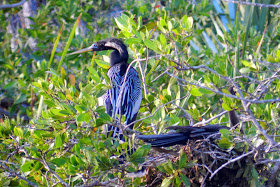 |
The “Lower Keys” consists of Big Pine Key to Key West.
|
Because of this coral reef, the ground is very hard, beaches are not that sandy, and there is coral EVERYWHERE. This also means that freshwater is able to be held in what is referred to as a “lens” just under the surface of the ground. Elevation on Big Pine is less than 5 feet above sea level, and it is probably more accurate to say its less than 2 feet in elevation. This lens just hovers under the surface, and has allowed animals and people to inhabit this island. There are many freshwater wetlands on Big Pine Key, which is surprising to many, including myself. While I’m out on the Refuge, I’ve noticed many shallow, open water habitats, all of which is freshwater.
Many years ago, when these islands were really being developed, in an attempt to raise roads, the railway and buildings, some of this fossilized coral, now limestone, was quarried. Have you ever dug a hole in the ground, and hit the water table? That’s what happens here, in the quarries.
 |
| The Blue Hole at dusk. |
The Blue Hole is probably most famously home to several alligators (Alligator mississippiensis). These ‘gators can be seen often sunning themselves, from the safety of a wooden observation deck overlooking the pond. Of course these are wild animals, and there is no fence keeping them contained, so visitors should keep their distance, and refrain from feeding them.
 |
| One of the 'gators seen at Blue Hole. |
 |
| Male (standing) and female on nest. |
This night, I was fortunate to watch the female take over the nest from the male. The video quality isn’t the best (sorry), my camera was constantly trying to focus, and I was without a tripod! Still, it was awesome to watch.
 |
Mom is now on the nest, and dad tends to her and the nest.
|
 |
A White-crowned Pigeon
seen feeding amongst poisonwood.
|
These birds are at their northernmost range in Florida, but are common throughout the Caribbean island. They are even hunted and eaten in those islands. Here in Florida though, they are protected. I am glad to add another member of this Pigeon/Dove family to my bird list, to expand past the Rock Dove and Mourning Dove!
While I was trying to photograph the above Pigeon, I kept hearing a musical song and frenetic movement in the canopy over me. I couldn’t get a good look at it, as it was moving quickly and it was reaching dusk. I finally was able to pinpoint it, and get a good look at it. The picture below is the best I could do given the lighting and the bird’s behavior. Before I left Blue Hole for the night, I was guessing that I had photographed a warbler or vireo, just based on it’s location in the canopy, and I saw it feeding on insects (both warblers and vireos are insectivorous).
 |
White-eyed Vireo (Vireo griseus)
|
After getting home, and sending my picture to my ornithology professor from SUNY Cobleksill, I confirmed that it was a White-eyed Vireo. Check it out at All About Birds: White-eyed Vireo, and give it’s song a listen.
The last bird I got the chance to see, was an Osprey (Pandion haliaetus). He was quite a distance away, sitting on a snag. But the sky was beautiful behind him, so he’s included!
 |
| Osprey at Blue Hole |
The FINAL cool critter I saw over at Blue Hole the other night was a Florida softshell turtle (Apalone ferox). We had a soft shell in our herpetology lab at Cobleskill, which could fit in the palm of my hand. It was so different than any other turtle or tortoise I had seen. Their shell is leathery and soft, and they have a little snout on them, which they can use as a snorkel!
I saw this Florida softshell at Blue Hole, right next to an alligator. They were totally unconcerned with each other. This turtle was probably 12-14″ from end to end of his carapace (top shell). Really cool animal.
 |
| Florida softshell turtle |


This is very different from your time in Alaska, and lovely video, it looks as though they are so careful not to leave the nest open for any time at all, and her eyes!!! So clear. Lovely turtle, I can see you are having a great time down there. Cheers, Jean.
ReplyDeleteIt is so interesting - what a change for you!!!! The birds are incredible, and it's fun to learn about the Keys.
ReplyDelete